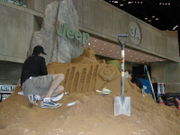Sand art and play
2007 Schools Wikipedia Selection. Related subjects: Recreation
A sand castle is a type of sand sculpture which resembles a miniature building, often a castle. The two basic building ingredients, sand and water, are available in abundance on a sandy beach, so most sand play occurs there or in a sandpit.
A variant on the sand castle is the drip castle, made by mixing extra water in with the sand, and dripping this wet sand from a fist held above. When the slurry of sand and water lands on existing sand structures, the water is rapidly wicked away, leaving the blob of sand in place. The effect is Gaudi-esque.
Sand castles are typically made by children, simply for the fun of making them. However, adults sometimes engage in contests making sand sculptures, in which the goal is to create structures which don't appear to be constructed just from sand; they can become large and complex. Other vulnerable media are ice and snow, leading to ice sculptures and snow sculptures.
Adults may find sand castle construction to be almost "Zen-like" in its ability to create total focus and relaxation. Whether an hour or a day, alone or with a group of friends or family, sand castle play is increasingly seen as adult leisure time activity for beach vacationers.
An example of extremely sophisticated sand art is the Buddhist mandala.
Construction
The sand must be fine, or the wetted grains will not stick together. Dry sand is loose, wet sand adherent, except when it is too wet. Sand used in the construction may dry or get wetter, changing the integrity of the structure; " landslides" are common.
The main tools for construction are a shovel, although using the hands alone is common, and a bucket or other container to bring water from the sea to the construction site. Also, pieces of wood, etc. can be used to reinforce structures.
Sand sculpting has been around for many decades and has become very popular more recently with hundreds of competitions held all over the world every year. It has become quite sophisticated and can be found in Guinness World Records, as well as in many commercial and promotional applications. Some advocates are purists, using no artificial materials, no formwork or coloring, no adhesive or heavy machinery. One such artist, G. Augustine Lynas, has been doing public sculptures for more than 50 years. However, in sand sculpting competitions, the rules often permit or even dictate that the finished sculpture be sprayed with a stabilizing coating in order to preserve the form for more than a day, allowing time for judging and appreciation by visitors. Coated sculptures may stand for months, until they are deliberately destroyed to make way for new competitons.
Alternatives to sand castles
One of the main attractions of a sandy beach, especially for children, is playing with the sand, with more possibilities than a sandbox. One can make a mountain, a pit (encountering clay or the water table), canals, tunnels, bridges, a sculpture (representing a person, animal, etc. like a statue, or a scale model of a building), etc. Tunnels large enough to enter are extremely hazardous; children have been killed by collapses of underground chambers and such a collapse is guaranteed if wave wash reaches the structure. If a small stream enters the beach, one or more dams can be constructed to hold back lakes of stream water. Almost as much fun as building beach dams is deliberately breaking them to cause a flood. If the beach is at an ocean, or at a sea connected to an ocean then there can be tides. These tides add attractive dynamics: on flood-tides the rising water enters previously dry ditches and pits, and one can try to keep areas dry by dikes, etc.; on ebb-tides one can try to keep water in a canal by deepening it and lengthening it, keeping it connected to the retracting sea. If one returns the next day much erosion is apparent—in fact only large excavations at all survive one excursion of the tide, and beach dynamics soon enough smooth out the surface, erasing everything.
Partial burying
A common form of playing with sand is burying someone else partially, in particular up to the neck. To a lesser extent one can also bury oneself. Various human positions are possible.


